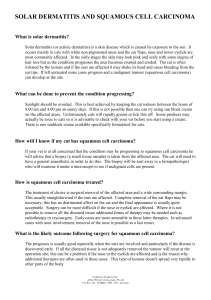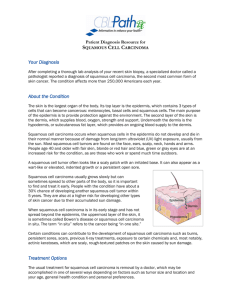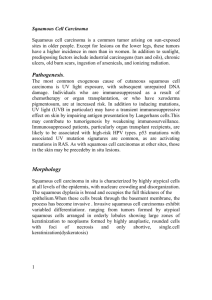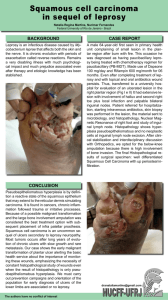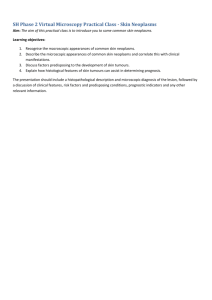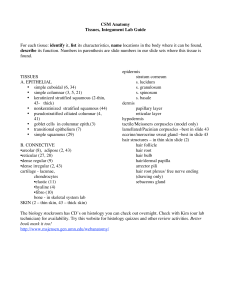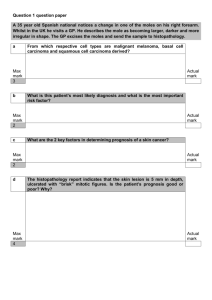PowerPoint slides - Research To Practice
advertisement
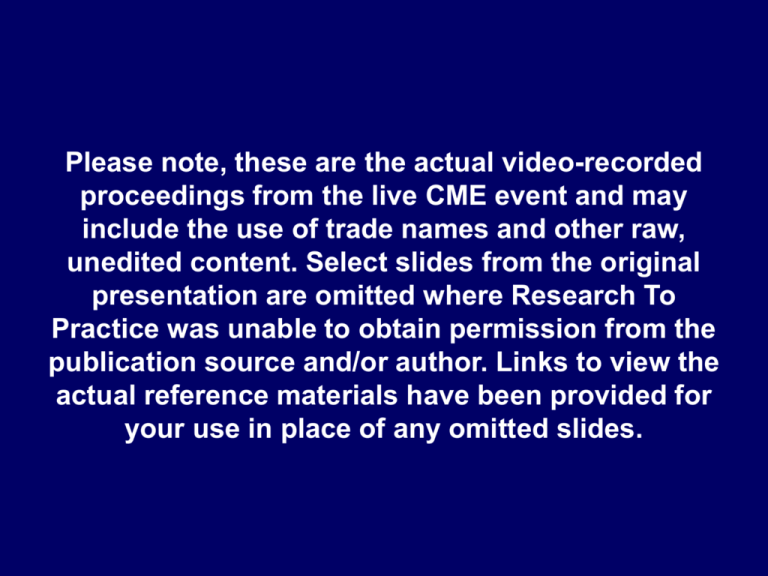
Please note, these are the actual video-recorded proceedings from the live CME event and may include the use of trade names and other raw, unedited content. Select slides from the original presentation are omitted where Research To Practice was unable to obtain permission from the publication source and/or author. Links to view the actual reference materials have been provided for your use in place of any omitted slides. Saturday, February 11, 2012 Hollywood, Florida Co-Chairs Rogerio C Lilenbaum, MD Co-Chair and Moderator Neil Love, MD Mark A Socinski, MD Faculty Chandra P Belani, MD John Heymach, MD, PhD Pasi A Jänne, MD, PhD Thomas J Lynch Jr, MD Heather Wakelee, MD Clinical Challenges and Opportunities in Squamous Cell Carcinoma Mark A. Socinski, MD Professor of Medicine and Thoracic Surgery Director, Lung Cancer Section, Division of Hematology/Oncology University of Pittsburgh Overview of NSCLC Histologies NSCLC adenocarcinoma NSCLC large cell carcinoma NSCLC squamous cell carcinoma Adenocarcinoma is a malignant epithelial tumor with glandular differentiation or mucin production, showing acinar, papillary, bronchoalveolar, or solid with mucin growth patterns or a mixture of these patterns. Large cell carcinoma is an undifferentiated non-small cell carcinoma that lacks the cytologic and architectural features of small cell carcinoma and glandular or squamous differentiation. Squamous cell carcinoma is a malignant epithelial tumor showing keratinization and/or intercellular bridges that arise from bronchial epithelium. These features vary with degree of differentiation, being prominent in welldifferentiated tumors and focal in poorly differentiated tumors. Pathology and Genetics of Tumours of the Lung, Pleura, Thymus and Heart. IARCPress. 2004:26-30. Retrospective Analysis of ECOG 1594 by Histology Squamous (n=224) OS (mo) Large Cell (n=74) Other (n=194) Regimen Median 95% C1 Median 95% C1 Median 95% C1 Median 95% C1 pvalue CP 6.9 (5.3, 9.4) 9.1 (7.9, 10.9) 6.1 (2.9, inf) 6 (3.9, 9.1) 0.09 CG 9.4 (5.7, 15.5) 8.1 (6.8, 9.8) 9.7 (4.5, 17.1) 7.9 (6.3, 11.3) 0.63 CD 8.1 (5.5, 11.2) 7.7 (6.5, 9.4) 6.8 54.9, 11.7 8.2 (5.6, 12.4) 0.01 CbP 9.3 (7.3, 12.1) 7.6 (6.6, 9.8) 8.3 (3.6, 16.7) 6.9 (4.9, 11.6) 0.37 p-value PFS (mo) Adenocarcinoma (n=647) 0.18 0.39 0.37 0.82 CP 2.6 (1.7, 4.2) 3.7 (3.1, 4.3) 3.5 (1.4, inf) 2.8 (1.8, 4.0) 0.43 CG 4.1 (3.3, 6.6) 4.4 (3.8, 5.4) 4.5 (2.0, 11.5) 3.4 (2.8, 5.1) 0.43 CD 3.1 (2.4, 5.0) 3.7 (2.6, 4.6) 4.2 (2.0, 6.6) 3.6 (2.7, 5.6) 0.54 CbP 3.7 (3.0, 5.0) 3.5 (2.9, 4.2) 3.9 1.9, 7.8) 2.2 1.7, 3.9) 0.25 p-value 0.2 0.19 0.56 0.68 Histological subtypes did not influence overall survival and progression free survival in chemo-naïve patients treated with platinum-based doublets involving paclitaxel, docetaxel or gemcitabine Tien H et al. J Thorac Oncol 4:S493, 2009 Why did we start caring about Squamous cell carcinoma? Bleeding in a Randomized Phase II Trial 6 life-threatening PHs; 4 fatal •Overall incidence: 9% (6/66) •5 occurred with bevacizumab 7.5 mg/kg Apparent risk factors •Baseline hemoptysis •Histology - Squamous histology: 31% (4/13) - Non-squamous histology: 4% (2/53) Squamous histology patients subsequently excluded from the pivotal phase III trial (ECOG 4599) Johnson. J Clin Oncol. 2004;22:2184; Sandler. New Engl J Med 355:2542-50, 2006. Pemetrexed in Squamous Carcinoma First line: Median survival • CP: 9.4 months; 95% CI 8.4, 10.2 • CG: 10.8 months; 95% CI 9.5, 12.1 – Adjusted HR; 95% CI: 1.23; 1.00, 1.51 Maintenance • Pemetrexed, 9.9 months • Placebo, 10.8 months – HR = 1.07 (95% CI: 0.49-1.73) – p = 0.678 Scagliotti, G. V. et al. J Clin Oncol; 26:3543-3551 2008 Ciuleanu T et al. Lancet 374:1432-1440, 2009 Heterogeneity of mRNA Expression Levels in NSCLC: AC versus SCCA NSCLC Total NSCLC Squamous NSCLC Adenocarcinoma SCCA vs AC N = 1,802 (SCCA) N = 392 (AC) N = 920 p-value N 1,014 264 500 Median 2.92 4.31 2.5 Range 0.14-60.58 0.14-59.16 0.39-30.33 Biomarker TS * Mann-Whitney test Gandara D et al. ASCO 2010 (Reference <2.33 for pemetrexed) % Below Reference Level NSCLC-Total 41.3% NSCLC-Adenoca 45.7% NSCLC-SCCA 25.9% <0.001* New Cytotoxics in Squamous Cell Carcinoma Phase III nab-P/C vs P/C Study Design Socinski MA et al. ASCO 2010, LBA# 7511 Chemo-naive PS 0-1 Stage IIIb/IV NSCLC N = 1,050 nab-Paclitaxel 100 mg/m2 d1, 8, 15 Carboplatin AUC 6 d1 No Premedication n = 525 1:1 Paclitaxel 200 mg/m2 d1 Carboplatin AUC 6 d1 With Premedication of Stratification factors: Dexamethasone + Antihistamines Stage (IIIb vs IV) n = 525 Age (<70 vs >70) Sex Histology (squamous vs nonsquamous) Geographic region Results: Baseline Demographics nab-P/C (n = 521) P/C (n = 531) All Patients (N = 1052) 60 (28, 81) 448 (86) 73 (14) 60 (24, 84) 449 (85) 82 (15) 60 (24, 84) 897 (85) 155 (15) Female, n (%) 129 (25) 134 (25) 263 (25) ECOG, n (%) 0 1 Histology of Primary Diagnosis, n (%)* 133 (26) 385 (74) 113 (21) 416 (78) 246 (23) 801 (76) 254 (49) 228 (44) 264 (50) 221 (42) 518 (49) 449 (43) Large Cell Carcinoma 9 (2) 13 (2) 22 (2) Other 29 (6) 33 (6) 62 (6) Stage III 99 (19) 107 (20) 206 (20) Stage IV 421 (81) 424 (80) 845 (80) 12 (2) 8 (2) 20 (2) 513 521 1034 Never Smoked 138 (27) 144 (28) 282 (27) Smoked and Quit 165 (32) 146 (28) 311 (30) Smoked and Still Smokes 210 (41) 231 (44) 441 (43) Age, median (range) years <70 years, n (%) ≥70 years, n (%) Adenocarcinoma Squamous Cell Carcinoma Stage at Current Diagnosis, n (%)* Prior Chemotherapy, n (%) Smoking Status, n (%) *Data was missing for 1 pt at the time of this analysis Primary Endpoint Results (ITT Population) Objective Response Rates – All Histologies Percent Responses 50% Response Ratio = 1.31 Response Ratio = 1.26 (1.082 – 1.593) (1.060 – 1.496) P = 0.005 P = 0.008 nab-P/C (n = 521) P/C (n = 531) 40% 30% 20% 37% 33% 30% 25% 10% 0% Independent Radiologic Review Investigator Assessment Objective Responses by Histology Squamous P < 0.001 Nonsquamous P = 0.060 P = 0.808 P = 0.069 Percent Responses 50% 40% nab-P/C P/C 41% 37% 37% 30% 29% 20% 24% 30% 26% 25% 10% 0% Independent Radiologic Review n = 228 Investigator Assessment n = 221 Socinski MA et al. ASCO 2010 #7511 Independent Radiologic Review n = 292 Investigator Assessment n = 310 Secondary Endpoints: PFS and OS Carboplatin/ paclitaxel Carboplatin/ nab paclitaxel Hazard ratio p-value Median PFS — all patients (n = 531, 521) 5.8 months 6.3 months 0.902 0.214 Median OS — all patients (n = 531, 521) 11.2 months 12.1 months 0.922 0.271 Exploratory Overall Survival Analysis in Selected Strata Carboplatin/ paclitaxel Carboplatin/ nab paclitaxel Hazard ratio p-value 9.5 months 10.7 months 0.890 0.284* 10.4 months 19.9 months 0.583 0.009* Squamous (n = 221, 229) Age ≥70 years (n = 82, 74) * Subgroup analyses exploratory in nature Nab Paclitaxel Phase II Trial In Advanced Squamous Carcinoma of the Lung Gemcitabine Carboplatin R Primary Endpoints: ORR N=120 Nab-paclitaxel Carboplatin NCT01236716 Chinese Society of Lung Cancer Trial Outcome with Targeted Agents in Squamous Cell CA Agent Bevacizumab Sorafenib Motesanib Cediranib Figitumumab Cetuximab Trial Phase II Phase III ESCAPE Phase III MONET Phase II BR24 Phase III ADVIGO (2) Phase III FLEX Results Associated with increased risk of severe pulmonary hemorrhage (4/13 pts) Increased risk of death Increased risk of hemoptysis No increased toxicity or efficacy No histology specific findings but increased toxicity and no benefit No histology specific findings FLEX Overall Survival Time: ITT No. of events Median OS, months [95% CI] CT + Cetuximab (n = 557) CT (n = 568) 421 447 11.3 [9.4–12.4] 10.1 [9.1–10.9] HR [95% CI] 0.871 [0.762–0.996] p-value 1-year survival, % 0.044 47 42 OS by Subgroups: Ethnic Origin and Histology (ITT) Median OS (months) CT + Cetuximab CT HR [95% CI] p-value All (n=1125) 11.3 10.1 0.871 [0.762–0.996] 0.044 Caucasian (n=946) 10.5 9.1 0.803 [0.694–0.928] 0.003 Adenoca. (n=413) 12.0 10.3 0.815 [0.649–1.023] 0.077 SCC (n=347) 10.2 8.9 0.794 [0.626–1.007] 0.057 17.6 20.4 1.179 [0.730–1.905] 0.499 Asian (n=121) High and low EGFR expression High EGFR expression • IHC score ≥200 Low EGFR expression • IHC score <200 O’Byrne et al. J Thorac Oncol 2010 FLEX survival: High EGFR expression Squamous cell carcinoma (N = 144) Survival Median 1-year CT + cetuximab 11.2 mo 44% CT 8.9 mo 25% HR = 0.62 [95% CI 0.43–0.88] Ongoing Trials in Squamous NSCLC Iniparib in Untreated Stage IV Squamous NSCLC DNA replication DNA DSB DNA SSB Chemo PARP Base excision repair Iniparib ATM/ATR wt p53/ mt p53 γ-H2AX BRCA1 Rad50 MRE11 NBS1 RAD51 BRCA2 Rad52/4 RPA ERCC1 Adapted from N.J. Curtin, 2006 Homologous Recombination Repair (HR) Target Cancers = defective in HR BRCA1/2 mutant (breast, ovarian), ERCC1 abnormalities (colon, NSCLC), p53 mutant tumors. ECLIPSE Study Overview N= 825 International, Open-label Gemcitabine + Carboplatin Patient Population: • Advanced squamous cell carcinoma R Endpoints: Primary: OS Secondary: PFS, TTP, ORR, safety/tolerability, QoL Doses: Gemcitabine 1000 mg/m2 D 1 & 8 q3wk Carboplatin AUC 5 D1 q3wk; Iniparib 5.6 mg/kg IV D 1, 4, 8 & 11 q3wk 1:1 • Patients restaged by CT scans (per RECIST 1.1 version) q 2 cycles (6 wks) • Patients may remain on study regimen after 6 cycles if there is no evidence of PD or the presence of DLTs Gemcitabine + Carboplatin + Iniparib First Patient Enrolled: March 5, 2010 Necitumumab • Fully human IgG1 monoclonal antibody to EGFR • Increases antitumor activity when combined with gemcitabine/cisplatin or pemetrexed/cisplatin in NSCLC xenografts • First in human study: DLT grade 3 headache associated with nausea, vomiting, and fever (2 pts) RP2D 800 mg weekly or every 2 weeks PR-2 pts; SD-16 pts Kuenen B et al. Clin Cancer Res 15:1915-1923, 2010 SQUIRE: Phase III, 1st line NSCLC, squamous 947 patients Stage 4 NSCLC Squamous ECOG PS 0-2 R A N 1 D O M I Z E 1 Arm A: IMC-11F8 + CIS + GEM IMC-11F8 800 mg (50-min IV), D1, 8 Cisplatin 75 mg/m2 (30-60 min IV), D1 Gemcitabine 1250 mg m2 (30 min IV), D1, 8 Arm B: CIS + GEM Cisplatin 75 mg/m2 (30-60 min IV), D1 Gemcitabine 1250 mg/m2 (30 min IV), D1, 8 PR CR IMC-11F8 SD PD Squamous Cell Lung Cancer: An Unmet Need • Platinum Doublets remain the standard of care – Gemcitabine- or Taxane-Based Regimens Commonly Used (? Role of Nab-paclitaxel) • Antiangiogenic strategies are felt to be too toxic • Pemetrexed no longer approved for use in this subset • Cetuximab + cisplatin-vinorelbine (FLEX study): improved median OS (10.2 vs 8.9 months) in SQLC – Not FDA-Approved • New strategies are needed for this large group of patients Saturday, February 11, 2012 Hollywood, Florida Co-Chairs Rogerio C Lilenbaum, MD Co-Chair and Moderator Neil Love, MD Mark A Socinski, MD Faculty Chandra P Belani, MD John Heymach, MD, PhD Pasi A Jänne, MD, PhD Thomas J Lynch Jr, MD Heather Wakelee, MD
